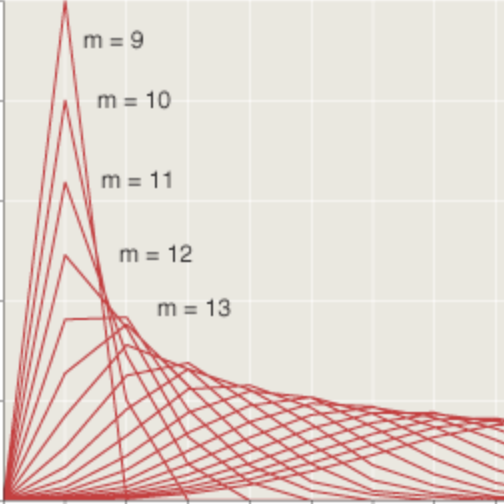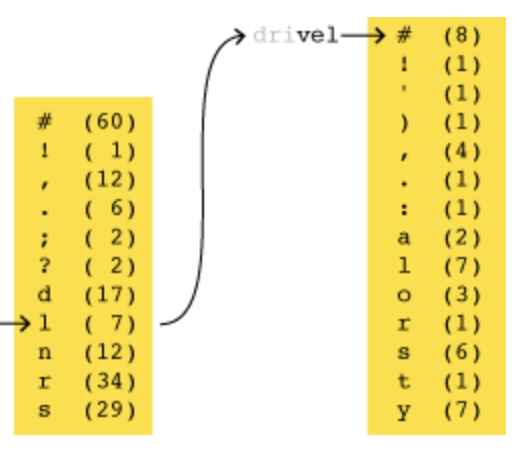My First 1000000 Years
by Brian Hayes
Published 10 December 2013
Limites
Hay una línea de Verlaine que no volveré a recordar,
Hay una calle próxima que está vedada a mis pasos,
Hay un espejo que me ha visto por última vez,
Hay una puerta que he cerrado hasta el fin del mundo.
Entre los libros de mi biblioteca (estoy viéndolos)
Hay alguno que ya nunca abriré.
Este verano cumpliré cincuenta años:
La muerte me desgasta, incesante.
—Jorge Luis Borges, 1923
Passing half a century is a landmark for those who count on 10 fingers, but as a bit-player I celebrate powers of 2. Today I turn 26, which is a mega-milestone: 10000002 years. It’s a special occasion in several ways. Need I point out that it’s the last power of 2 I’ll ever see? Also, other than 0 and 1, it’s the only sixth power I’ll visit in my lifespan, and hence it is the only age that’s both a square and a cube.
As a young man—well shy of 50—I admired that poem by Borges, but as I grow older I find its mood of lugubrious foreboding less attractive. Yes, it’s true: There is a line of Borges I’ll never read again. But if my time is so limited, I shouldn’t be spending too much of it stuck in a tight loop, rereading the same lamentations over and over. Let the last time pass; I’ll move on to something new—something I haven’t yet done for the first time.
Life is all too full of never-to-be-repeated moments, right from the outset. Even the silly numerology of birthdays makes this apparent. Long before I reached my last power of 2, I celebrated my last Bell birthday (52), my last Catalan birthday (42), my last perfect birthday (28), my last factorial birthday (24), my last pair of birthdays satisfying \(x^m - y^n = 1\) (\(2^3 = 8, 3^2 = 9\)). Never again will my age be an even prime number, a multiplicative identity, an additive identity. But I can live with that!
And I still have a few treats to look forward to. In a couple of years I come to my next triangular birthday—and that one may not be my last. Then of course there’s \(3^4 = 9^2\). At the end of my eighties there’s a Fibonacci waiting for me, if I can make it. And, nearer at hand, I have marked my calendar for May 22, 2018, when I will celebrate my 25,000th spin around the earth’s axis. Maybe I should try to spend the day in orbit.
Responses from readers:
Please note: The bit-player website is no longer equipped to accept and publish comments from readers, but the author is still eager to hear from you. Send comments, criticism, compliments, or corrections to brian@bit-player.org.
Publication history
First publication: 10 December 2013
Converted to Eleventy framework: 22 April 2025




I wonder how you are counting spins around the Earth’s axis. A year, the time between two returns of the Earth to the same place in its orbit around the sun, comes to 365 days and a bit. But during that time, the Earth spins 366 times (and a bit) around its axis. It’s easiest to see this if you imagine a planet that always keeps the same face to the Sun (as the Moon does to the Earth). Someone on the sunny side will experience no sunset, no sunrise, no days during a year, but one rotation of her planet around its axis. Or see the Wikipedia essay on sidereal time.
Ah, I should have thought of the solar vs. sidereal issue. (Thank goodness I’m not quite old enough to have to worry about Julian vs. Gregorian calendars.)
I’ve marked my calendar for March 15, 2018, as well. I’ll celebrate both.
And your current age in fibonacci base is a palindrom : 100010001.
Happy Birthday. I always enjoy your columns. I especially enjoy your hands-on approach - maybe a unique niche in the world of mathematics-computer science writing.
agree with you :)
perfect birthdays, perfect numbers, perfect columns.
just to maintain the level and perfect quoting:
Hay alguna que ya nunca abriré –> Hay alguno que ya nunca abriré
Thank you!